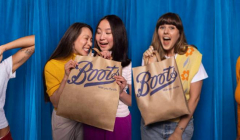
Boots captures the joy of saving
The Savvy Savers campaign features Boots shoppers celebrating the savings they’ve made.

Chelsea Lovell on how to better represent autistic people and people with learning disabilities in advertising

Representation for me is something that I didn’t really see as a child in the 00s. But then how do you show an invisible disability? Certainly, a visible disability is easier to show people.
As vice-chair of Dimensions Council, I’m committed to making change for autistic people and people with learning disabilities, and one way this could be achieved is through greater representation in advertising.
I think seeing people who have learning disabilities and autism in a magazine advert would make me want to tell the world about it. Imagine an advert that shows the reality of our life - that shows the people I grew up with, the people I went to special educational needs (SEN) clubs and school with, or the people I work with. It’s all part of my story.
Imagine a magazine showing people with a support worker with a lanyard or a work fleece, standing there, with the person they support, advertising a kitchen blender. It would be such a mundane thing, but it could have a big impact. Or a TV ad of a mum signing to her child that they need to put their boots on or they will be late for school. Alternatively, it could be about online banking. It’s about showing our world - symbols, lanyards, signing, other disability aids, a supported living setting, a SEN club.
It’s about showing our world - symbols, lanyards, signing, other disability aids, a supported living setting, a SEN club.
Chelsea Lovell, Vice-Chair of Dimensions Council
When all the big Christmas ads are on the TV, everyone is talking about them. The news programmes and talk shows mention it, and how it feels, along with the Christmas countdown. Why can't we have one showing a group with diverse disabilities hosting Christmas dinner, as their family comes together? Why can't we have a person with a learning disability feeling excluded but there is a little mystery as to why? Or one with two children showing kindness to each other. Yet, I only see giant Venus fly traps, talking carrots, household objects, monsters under beds and aliens. Although, I did like the 2022 one of the skateboarders…
Last year there was an advert by Vanish featuring autistic people. I was so moved by it and I still am. I could see the people that grew up around me and I recognised the quirky movements. I remember seeing at least two girls who use to bite on their clothes. Seeing the girl in the sensory room also reminded of a play scheme I went to as a child, which had a white and dark sensory room. There was a familiarity with the environment that I grew up in. The story showed what it was like and how it felt. The relationship the girl has with her family makes me think of mine. However, I don’t think my mum would let me go home like she did.
I’m seeing the world around me change. Some of it is hopeful. I know that people with autism and learning disabilities want to be actors, dancers, and models, just like everyone else. This could start just by seeing people like themselves in adverts. The little girls and boys of today might be inspired by the next university advert, too.
I want to be in my late 40s or early 50s pottering around my home, glaring at the latest technology and whatever way we get our news by audio then. And I, half listening to it, hear it talk about how the representation of autism and learning disabilities has increased in advertising over 30 to 40 years. I want to be staring at the news source going “What?”, and that I can't believe it has been that long and how much we have done. I will have to check the internet in whatever way we get it, and I will see the data. Maybe someone is calling me because they have seen or heard about it.
It will be funny to think that we might be in disbelief in the future if we get this right. Seeing old ads, we might look back on it and wonder how it went on that way for so long. Like we do about sexism in the 1940s and 50s.
Chelsea is the Vice-Chair of Dimensions Council. She is also one of the hosts of the Dimensions Council podcast, along with being a Quality Consultant. Chelsea has lived experience with Autism and ADHD. She uses this in her work and to make change. Chelsea is also a writer. Maybe she will be in your local book shop someday. Chelsea wants to see want better autism representation in the media.
Looks like you need to create a Creativebrief account to perform this action.
Create account Sign inLooks like you need to create a Creativebrief account to perform this action.
Create account Sign in